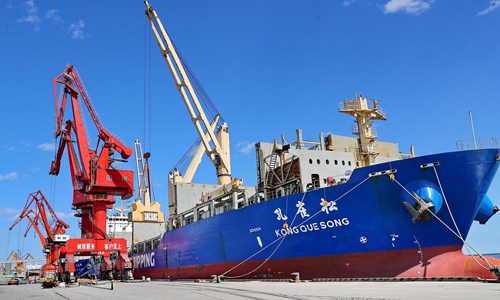China-EU cooperation should not be derailed by misleading Western voices
By Wang Jiamei Source:Global Times Published: 2020/6/22 16:48:40

The last batch of 5,500 tons of materials has been transported from Qinhuangdao, North China's Hebei Province to the Port of Mongla in Bangladesh for construction of the Padma Bridge. The Chinese-built project is proceeding under the Belt and Road Initiative. Despite the COVID-19 outbreak, work is proceeding normally. Photo: cnsphoto
Certain Western media outlets are tireless in exaggerating any setback related to the China-proposed Belt and Road Initiative (BRI), but that is a sign of the growing influence of the grand economic cooperation and development plan.
Last week, the EU decided to impose an anti-subsidy duty on imports of glass fiber fabrics from two Egypt-based Chinese exporters, citing the "market-distorting aid" from the Chinese and Egyptian governments that the companies received. Both companies are based in the China-Egypt Suez Economic and Trade Cooperation Zone (SETC-Zone), a program under the BRI infrastructure plan. According to the European Commission, "The governments of Egypt and China have pooled their resources to provide the companies manufacturing in the SETC-Zone with favorable conditions that confer benefits to them."
Since the development marks the first time that the EU has punished exporters located in a third country for receiving government aid, some Western media have hailed the case as landmark and one that takes aim at the BRI.
However, from another perspective, the EU's reaction may serve as the latest example of the increasing influence of the economic cooperation between China and European countries under the BRI framework. Trade may be only one aspect of the rising economic impact that the EU is inevitably feeling.
It should be noted that the BRI is an ambitious plan whose like has never been put forward before, and that means it will inevitably face various challenges in terms of the economy, politics, and diplomacy, among others. Thus it is entirely understandable and normal that the BRI cooperation between China and Europe will encounter some small setbacks during the construction process.
While misleading views of the BRI are not uncommon these days, it would be narrow-minded to earnestly guard against the potential of BRI cooperation. If countries did not stand to benefit from the BRI program, there would not be so many countries and organizations interested in it. If anything, the EU should realize that the foundation of the plan is China's potential, which is reflected in its huge labor market and consumer demand. And BRI cooperation will stimulate new opportunities in China's market, which will certainly do more good than harm for Europe as a whole.
That is why we hope the EU, in the context of the new Cold War between China and the US, can overcome the challenges and take a pragmatic approach toward BRI cooperation with China, with more economic thinking and less geopolitical consideration.
Posted in: ECONOMY